#the counterweight requirements??
Text
King and Prince 31
Part 30
The crowd was filled to the brim. Eddie’s inner circle was seated in the royal viewing box. Eddie wasn’t there yet though. Because of course he had to make an entrance. As a great black bird, he flew over the venue, his cry echoing through the field. He landed in the center of the arena in an explosion of black shadows as he took his human form to the cheers of his subjects.
“Dearest people of the land!”, he addressed. “We have gathered to settle the dispute between two men. But before I introduce them, let me settle the rumors. I am indeed courting Steven of the house Harrington.”
There was a hushed murmur among the audience. So it was true. Their king was trying to gain the favor of a prince from a country that had until recently been challenging their borders. The people had chalked up the lull in activity to the usual break when the demobeasts went into hibernation. But could it have been because of this? Eddie wouldn’t reveal that Steve had been taken hostage and had turned into a ward of his castle. That was Steve’s story to tell should he wish it. Eddie would only say what his people deserved to know.
“That brings us to today. For one man has sullied the names of us both and my intended requires satisfaction.” He was beaming, happy to have someone who burned with a righteous fury for him.”Without further ado! Our combatants!” He gave a sweeping bow to applause as Jason and Steve entered from opposite sides of the arena.
“Jason Carver has laid down words that he refuses to take back. Steven Harrington has thrown down the challenge. What are the terms?”
“Apologize to your sovereign and swear fealty, or meet your end at my hand”, Steve said, expression hard and unforgiving.
“I will do no such thing. And when you yield to me, your only path will be banishment”, Jason replied, face just as stern.
The clasped arms and then turned to go back to opposite ends of the arena. Eddie floated over to the viewing box and waited for both of them to grab their weapons of choice. Jason picked up a sword and shield, a classic decision. When he turned to meet Steve’s gaze, he could see that the prince’s choice wasn’t quite as common.
Steve went without a shield. And grasped tightly in both hands instead was a war hammer. The staff stopped just short of his shoulder, the head about twice as large as his own. The rod ended with an iron counterweight. Eddie looked to Lucas.
“Has he been training with that this whole time?”
“He’s a pro”, Lucas praised.
Dustin’s whole mouth showed with his smile. “Carver is about to get tenderized like a steak.”
“A brutish weapon befitting a barbarian”, Jason said, more to the crowd than to Steve.
Steve’s expression didn’t change as he got in his stance and waited for Eddie to officially start the bout. Eddie stood from his seat, his voice reverberating through all in attendance as he shouted.
“BEGIN!”
Jason did catch Steve a little off guard when he lunged first, closing the distance between them. With the kind of weapon Steve was wielding, most would keep away. But he could guess as to why Jason wanted the first blow. He wanted this to be quick and decisive. Anyone would fold with a few well placed cuts and stabs.
He was probably also hoping to tire Steve out. Steve would make sure it wasn’t so easy for him. When Jason lunged, he stepped out of the way and swung his hammer. Jason raised his shield to take the blow and blocked it well, but his eyes popping said he hadn’t been expecting the power behind it.
Jason re-evaluated, taking a step back. And where he retreated, Steve would advance, making wide swings that had Jason backing up even more.
Eddie’s hands were clenched into fists in his lap. He had caught Steve training Lucas a couple times and sure he took things seriously, but it was a master putting a student through his trials. Eddie hadn’t been allowed to view Steve’s personal training this week. But he’d seen knight after knight tending to their bruises. If he’d been able to watch Steve then, was this the sight he would’ve seen? Steve moving like both a dancer and a predator, his hammer his loyal partner.
The hollers of the kids told him that even this was different than what they had seen. He imagined Steve wouldn’t attack his knights with the ferocity he was meeting Jason with. At one point, Steve slammed it down and Jason just barely jumped out of the way. When Steve pulled it back up, Eddie could see the dent in the ground. A hit in the right place and broken bones would be the least of Jason’s worries.
Then Steve stopped his onslaught, taking a breath as he circled Jason. When he started again, Jason raised his shield to each attempt, seemingly blocking them all.
“He’s gonna turn Carver’s arm to paste”, Nancy commented.
Part of the crowd was raising their voices in cheer for Jason, unable to see what Nancy’s eyes did. Steve kept going for Jason’s left side, wanting him to use his shield. Because while it stopped him from hitting Jason’s entire body, it still took the brunt force of the hammer coming down on it. And that was evident as each time his arm was slower and slower to rise.
Tired of being on the defensive, Jason lowered his shield to jab at Steve. He managed to get a few knicks in, going for Steve’s head each time and giving him cuts on his neck and face. Eddie’s leg bobbed anxiously. He didn’t think Steve would lose. The only question was how much damage would he take before claiming victory.
The crowd wasn’t sure what to make of Steve, many recognizing him from dominating the spring games but not knowing his true identity then. In a shocking move, Jason dropped his shield and threw his sword at Steve. He dodged and it lodged itself into the ground, but that confusion was enough of a distraction for Jason to tackle him to the ground. The staff of the hammer stood between them, both men pushing on it.
“Forfeit and all will be forgiven”, Jason said. “We will wed and this can all be forgotten. I’ll make an honest man out of you.”
“What?”
“You know I’m the right choice.”
With a roar, Steve pushed Jason off and rose up to his knees. “You’re vile and I’m going to end you.” he set his hammer, head side down and grabbed the sword Jason had been using. He tossed it back to him, waiting for him to pick it up.
When Jason did, Steve picked up his hammer again. This time he didn’t hold back. He advanced, forcing Jason to make fruitless slashes. Steve used the end of his hammer to knock Jason’s wrist, forcing him to drop the sword. He could see the fear in Jason’s eyes but didn’t let up. His next strike was with the head of the hammer, getting Jason right in the leg and making him fall to the ground.
Steve stood over him, hammer poised to strike. But he paused to look at Eddie, his shoulders rising and falling as he panted.
Eddie’s eyes had been glued to Steve’s form. As had everyone else’s. But at this pause, the crowd hushed, waiting for their king’s decision. Would he smile with grace on the Carver boy? Or would he approve his execution?
Eddie stood up. “He is at your mercy, Your Highness.”
It had been so long since anyone had referred to Steve like that. With any sort of respect or reverence for his title. He looked down at Jason, imagined his head cracking like a melon and the crowd cheering for him. The rightful order restored. He slammed his hammer down, splitting the ground under it, but not Jason’s head.
“You live by the grace of me”, Steve said, picking his hammer up and raising it above his head to thunderous cheers.
Jason was stationary on the ground until people came to gather him and check over his wrist and leg.
Eddie jumped out of the box and ran right to Steve, grabbing his free hand and lifting it up. “Our champion!”
Steve was able to deposit the hammer with one of those employed by the castle’s armory and Eddie walked him out of the arena. Once out of sight from most of the crowd, Eddie scooped Steve up and Steve let him, exhausted from the fight.
“You were magnificent, a vision, unstoppable. Like a divine spirit of justice incarnate. Poets could spend ages trying to capture your excellence in words and would fail to do so.”
“Oh but I’m certain you’ll try”, Steve teased as Eddie carried him back to his tent to be tended to and freshen up. There were games scheduled for the small folk and for children as well. No need to let this good weather and arena only see one bout today.
When Steve rejoined the public, it was on the arm of the king and to his viewing box where all who could see observed their lord and ruler feed this mighty warrior by hand. And Steve had been right about Eddie trying his damndest to capture his feats in writing. Because just the next day, he awoke to about half a dozen love letters all about the previous day’s fight.
Part 32
Taglist CLOSED
@thesuninyaface @only-evanescent @snakeorsquid @ignoremyworld @theclichefortunecookie
@goodolefashionedloverboi @just-a-tiny-void @0body0disphoria0 @cinnamon-mushroomabomination @samsoble
@jamieweasley13 @y4r3luv @xtkxkrzrizir @un-knownperson @greekgeek24
@justdrugsformethanks @potato-of-the-lord @notaqueenakhaleesi @swimmingbirdrunningrock @queenie-ofthe-void
@nebulainajar @lil-gremlin-things @nicememerino @robininblue @hornedqueenofhell
@anne-bennett-cosplayer @moomkin77 @here4thetrama @bookworm0690 @autumncrocusandladybug
@lil-gremlin-things @littlebluejane @puppy-steve
77 notes
·
View notes
Text
It is the future. Settling other planets has become possible. You volunteer for an experimental maternity program, to test the effects of low gravity on pregnancies + push the limits of human fertility, in order to get a colony up and running. As a result, you grow quite... large. Well, "large" drastically undersells it. You reach a size that would not be possible on Earth. Your belly enters the room a whole 30 seconds before you do, but you're still able to walk waddle, thanks to the reduced gravity... although still, numerous belts are required to keep your belly from touching the floor. With so many mouths to feed, and such a great weight hanging from your front, you've been outfitted with a hefty backpack, connected to a mask secured around your mouth. Not only is it a counterweight for your massive belly, it's constantly pumping oxygenated air into your nose to improve blood flow + funnels a thick nutrient paste into your mouth. Without these things, and other accommodations, it would be impossible to support a pregnancy of your size... a fact that fills you with no small amount of pride~
82 notes
·
View notes
Text
Tim and Damian: A Tale of Two Robins
The latest issue of Batman (# 147) clearly underscores the differing ways Tim and Damian each approach the role of Robin. It's why DC has been able to get away with having two very different characters simultaneously wearing the mantle.
For Damian, Robin is fundementally a position of honor and a source of pride. It's an affirmation of his unique status as the biological child of Bruce Wayne. Damian wants to do good and he wants to be the best at it. There's nothing wrong with that per say. Many heroes are driven by the same inner need for validation. Being Robin is an honor to which Damian feels he has earned the right.
For Tim, Robin is foremost a calling or vocation. The Robin mantle is definitely an honor but it's not the primary driving force behind why he's in the cape. To him Robin is much more than just a kid who fights with Batman. Tim is heavily invested in in protecting the symbolism of what both Robin as well as Batman and Robin stand for. Please note that it's not Damian or Dick that tracks Bruce down in this issue even though they're both quite capable of doing that. It's Tim who goes after Bruce.

Tim being the one to step up to save Bruce from his own worst impulses is what he does. He's an Emotional Support Robin as much as he is a partner to Batman. From the very beginning Tim saw Robin as someone Batman needs to function properly.
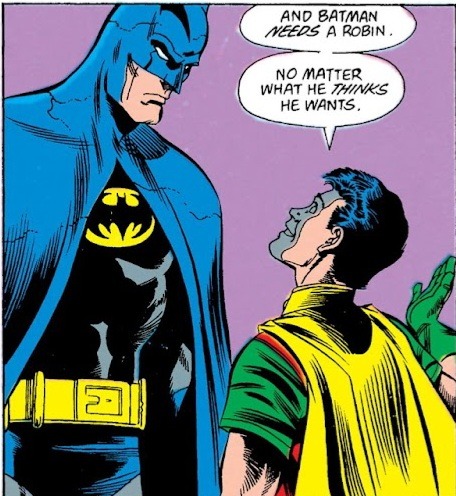
To this day Tim still maintains that Robin's primary responsibility is not to be a sidekick but be someone who will save Batman from both external and internal threats when required. He's a vital balance, a counterweight to the shadows that Batman inhabits.
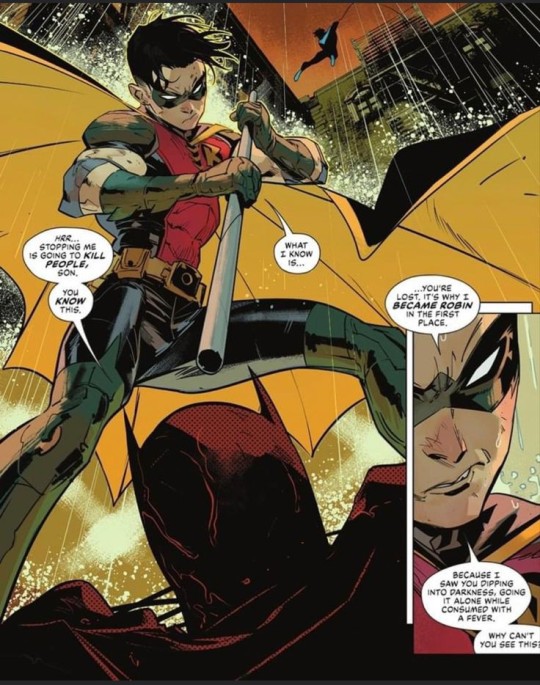
In many ways that idea is at the crux of the differences between Tim and Damian's approach to being Robin.

Damian initially saw the mantle of Robin as his birthright due to his being Bruce's biological son. Yes, it seems like a strange idea but let's cut the kid some slack. Damian was all of ten years old when he first met his father. He'd also been raised in a cult that all but worshipped the AL Ghul family. He was an arrogant little princeling because that's what he was raised to be.
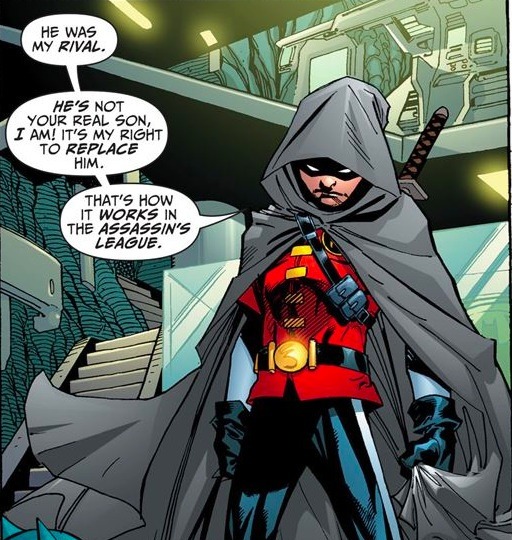
Tim sees Robin as Batman's partner but not his subordinate. Sure, all the Robins started as "sidekicks" but Dick and Jason's Robins never had the kind of independence Tim's Robin enjoys. Remember that it was a lack of autonomy that drove Dick away from Bruce in the first place. Jason's Robin rarely, if ever, worked independently of Batman. Tim, on the other hand, started handling his own cases less than a year after debuting in the role. Tim doesn't see himself as an apprentice but as a full partner. What's more he throughly enjoys that aspect of being Robin.

People wonder why Tim hasn't created a new identity that's not linked to Batman. The short answer is that Tim feels that he's already doing that. Robin is an independent hero and has been for years. He's been more than capable of operating without a net since before Damian showed up. Tim isn't shy about that view point, either. When Bruce tries to push Tim's Robin in ways Tim doesn't like, the kid will tell Batman "no" then continue doing things on his own .
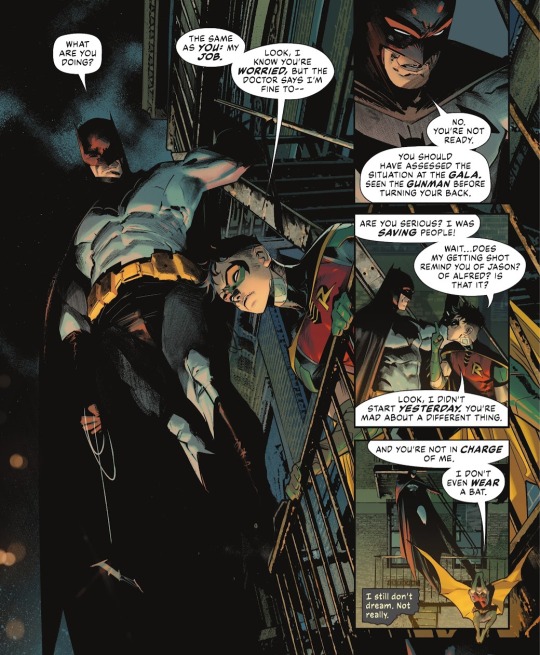
Damian, on the other hand, constantly chafes against how Bruce's Batman wants him to act as Robin. Just like his father Damian doesn't like to be wrong and that shared stubbornness causes the two of them endless arguments. Damian's earliest teachings within the League will forever be at odds with Bruce's demands of Robin. The clashing expectations cause an internal conflict that leaves him at war with both his father and himself. No wonder the poor kid has a short temper. Trying to be both Damian al Ghul and Damian Wayne has got to be exhausting.
It's a testament to Damian's strength of character that he's been able to overcome the indoctrination from the League as much as he has. It's never going to completely leave him, however, because the lessons engrained into Damian at such a young age formed the core of his personality. Working with Dick's Batman helped him to learn some empathy and the value of tempering his worst impulses. Unfortunately Damian is primarily working with Bruce not Dick.
Damian is also 13 years old who has been seeking his father's approval and respect since the day he met the man. Bruce, being the emotional disaster that he is, fails to recognize that most of the time. This is why Damian is so completely taken in by Zur pretending to be Bruce. For the first time Damian is getting both approval and positive attention for being more violent than is necessary. His dysfunctional childhood and his work as Robin are finally in harmony and Damian loves it. It's also why poor the poor kid is so crushed when he figures out what's going on.
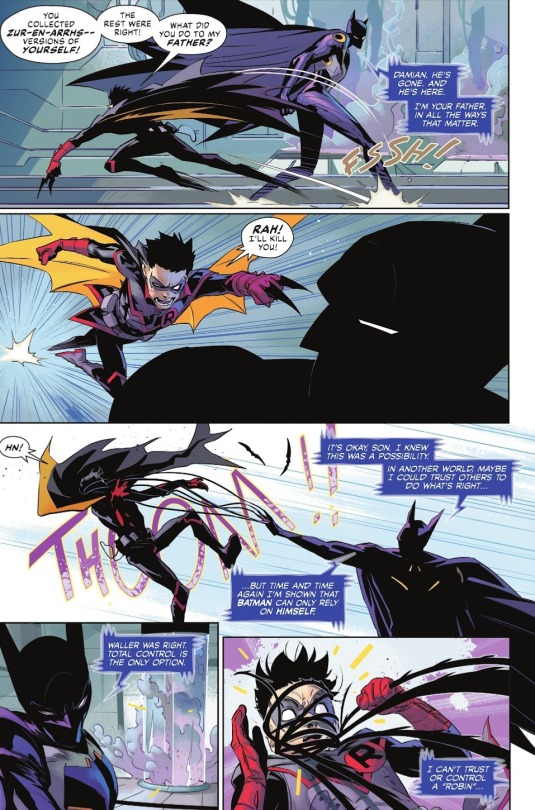
Tim, meanwhile, has stepped into his role as Emotional Support Robin (whether that's a good or bad thing is a debate for another time). His ability to ground Batman is why he can have this conversation with Bruce:


Tim also has one other crucial advantage that Damian, Dick or Jason never had. Tim was Bruce's partner long before he became his son. He's able to slide back into that role at the drop of a hat.
Damian will always be the son of Batman first and Robin second. That father/son dynamic that Bruce isn't very good at will try and lock Damian into a subordinate position in a misguided attempt to keep his son safe. That kind of micromanaging is something Dami will only tolerate for so long. Leaving Robin to take up a mantle of his own creation is all but inevitable.
Tim and Damian may both be Robin to Bruce's Batman but their perceptions of who and what Robin should be is radically different. And as I said before, that's not a bad thing at all.
#tim drake#tim drake robin#bruce wayne#batman#damian wayne#damian wayne robin#batfam#meara rants#yet another long winded opinion piece by bat-gran#sorry to ramble but this is my first creative atempt since my husband died
94 notes
·
View notes
Text
When Vaggie was new to Hell, she struggled a lot when it came to movement. She lacked depth perception, the counterweights of her wings, and her legs were weak from not being used often. She of course was still incredibly untrusting and so refused to acknowledge her weakness. So, Rosie was clever.
Dancing is incredibly popular among the cannibal colony, and Rosie convinced Vaggie to let her give her dance lessons so she would better blend in. At first Rosie picked a lot of dances that required a partner so she could help Vaggie balance, and transitioned into more solo dances as Vaggie got steadier.
Dancing is also a heck of a work out, so it helped strengthen Vaggie’s ground based movement muscles very quickly.
87 notes
·
View notes
Text
Lammy’s doctrine of “progressive realism” is a deliberate counterweight to the “ethical” foreign policy pursued by former Labour foreign secretary Robin Cook, which Lammy has said “snagged on the limits of what was possible”.
While Lammy expressed admiration for Cook’s idealism, he said he was “most informed” by Labour’s pragmatic postwar foreign secretary Ernest Bevin, who took on the Labour left with an Atlanticist approach that saw the birth of Nato and Britain’s adoption of nuclear weapons.
“I’m not going to be sitting down with proscribed terrorists, but diplomacy requires you to sit down with people who don’t share all your values,” he said. Saudi Arabia and Qatar, for example, were vital interlocutors in the search for peace in the Middle East.
"well obviously in determining the final solution to the palestinian question i would not sink so low as to negotiate with political-military organisations enjoying substantial support among the palestinian ppl and in particular those palestinians currently most severely affected by israels ongoing mass slaughter, i am ofc willing to sit down with more moderate parties with a stake in the debate, like islamist-theocratic absolute monarchies including one whose perceived willingness to abandon palestinian solidarity for the sake of normalised relations with israel is widely regarded as having catalysed the current round of heightened conflict"
126 notes
·
View notes
Text
what dimensions & counterweight would be required to trebuchet something into orbit
78 notes
·
View notes
Text
Wizard101 Power Leveling Guide (Summer 2024)
Updated July 22, 2024
This post is heavily inspired by the far more well-known Teleportable Dungeons guide on Reddit, so of course credit for the idea and MUCH of the information to the OP there. However, that guide was written in early 2020, and since then we've had a whole new arc, as well as some other changes. This guide aims to correct for those changes.
Along with teleportable instances and quests that either only require level progression or have no prerequisites, this guide includes every reusable housing gauntlet currently available. If you want to use this guide to its fullest but don't have a gauntlet yourself, you can message my acquaintance stormclouds_ on Discord, who can provide free and constant access to every gauntlet. (She gave me permission to cite her 👍)
The instances are listed in order of giving least to most XP. In the case of a dungeon providing multiple quests, it's ordered by the quest that gives maximum XP. Occasionally, I'll have notes in square brackets.
If a dungeon has both a Standard and Challenge mode, then I am strictly referring to Standard mode. You can't port into Challenge mode instances.
Accursed Play (Tier 1): 100 [If lowest wizard is Level 1-19]
Great Clock Tower (Tier 1): 100 [If lowest wizard is Level 1-19]
Accursed Play (Tier 2): 200 [If lowest wizard is Level 20-39]
Sinbad and the Iron Sultan (Tier 1): 200 [If lowest wizard is Level 1-25]
Great Clock Tower (Tier 2): 200 [If lowest wizard is Level 20-39]
Sunken City (Nightside, WC): 75 230 195 250 275
Accursed Play (Tier 3): 300 [If lowest wizard is Level 40-59]
Accursed Play (Tier 4): 300 [If lowest wizard is Level 60-79]
Sinbad and the Iron Sultan (Tier 2): 300 [If lowest wizard is Level 26-50]
Great Clock Tower (Tier 3): 300 [If lowest wizard is Level 40-59]
Great Clock Tower (Tier 4): 300 [If lowest wizard is Level 60-79]
Frostholm (Vigrid Roughland, GH): 320 320 320
Accursed Play (Tier 5): 500 [If lowest wizard is Level 80-99]
Great Clock Tower (Tier 5): 500 [If lowest wizard is Level 80-99]
Throne Room of Fire (Palace of Fire, KT): 600 645 205
Accursed Play (Tier 6): 700 [If lowest wizard is 100+]
Sinbad and the Iron Sultan (Tier 5): 700 [If lowest wizard is Level 101+]
Great Clock Tower (Tier 6): 700 [If lowest wizard is 100+]
Vault of Ice (Entrance Hall, KT): 735
Midnight Sun Pagoda (Tier 1): 779 [If lowest wizard is Level 1-19]
Emperor's Retreat (Entrance Hall, KT): 785 585 785 845
Karanahn Palace (Karanahn Barracks, KT): 915
Tomb of the Beguiler (Well of Spirits, KT): 685 785 895 960
Temple of Storms (Well of Spirits, KT): 960 960
Ironworks (Digmoore Station, MB): 1,005 1,360 400 435 1,430
Counterweight East (Royal Museum, MB): 1,480
Counterweight West (Royal Museum, MB): 1,520
Katzenstein's Lab (Scotland Yard Roof, MB): 1,480 1,480 1,520 475 485
The Stellarium (District of the Stars, CL): 1,595
Manticore's Madness (Nucleus Gallery, NV): 1,600 [Not recommended. This fight takes a LONG time for so little XP]
Kesington Park (Digmoore Station, MB): 1,565 1,580 1,640
Crimson Fields (Hametsu Village, MS): 335 665 665 2,085 335 2,085 2,095 1,675 2,095
The Grand Chasm Past (The Grand Chasm, DS): 715 2,230
Shirataki Temple (Shoshun Village, MS): 1,880 2,410
The Labyrinth (The Necropolis, DS): 830 2,580 2,580 2,580 2,580 2,580
Tree of Life (Yoshihito Temple, MS): 450 2,840 2,840
Spiral Cup Gauntlet (Tier 1): 3,175 [If lowest wizard is Level 1-19]
Grand Tourney Arena (Tier 1): 3,300 [If lowest wizard is Level 1-19]
Fantastic Voyage (Tier 1): 3,300 [If lowest wizard is Level 1-29]
Winterbane Hall (Tier 1): 3,375 [If lowest wizard is Level 1-19]
Kembaalung (begins in The Oasis, KT): 230 230 580 3,180 4,230 1,920 [Minimum level of 25 is required. Only the 3k and 4k figures are from dungeons, the rest are from quests that only require dialogue.]
Midnight Sun Pagoda (Tier 2): 4,650 [If lowest wizard is Level 20-39]
Loremaster (The Atheneum, DS): 7,300 [Though not a typical dungeon, wizards can accept her quest at any level and with no story progression necessary.]
Barkingham Palace (begins in Wolfminster Abbey, MB): 340 680 6,800 680 6,800 680 7,905 2,040 [Minimum level of 40 required. The 7k and 8k quests are from the dungeons themselves.]
Nastrond (Hrundle Fjord, GH): 5,375 8,955 10,075 5,375 10,075 9,850
Spiral Cup Gauntlet (Tier 2): 12,150 [If lowest wizard is Level 20-39]
Grand Tourney Arena (Tier 2): 12,675 [If lowest wizard is Level 20-39]
Fantastic Voyage (Tier 2): 12,675 [If lowest wizard is Level 30-59]
Winterbane Hall (Tier 2): 12,900 [If lowest wizard is Level 20-39]
Midnight Sun Pagoda (Tier 3): 14,730 [If lowest wizard is Level 40-59]
The Portico (Celestia Base Camp, CL): 21,125 17,420
The Chancel (Celestia Base Camp, CL): 3,040 10,345 23,375
Trial of the Spheres (Celestia Base Camp, CL): 25,000
Grand Tourney Arena (Tier 3): 31,085 [If lowest wizard is Level 40-59]
Zigazag (begins in Balance School, KT): 2,010 1,005 33,480 9,315 39,510 9,130 [Minimum level of 60 required. Dungeons award the 2 >30k quests.]
Spiral Cup Gauntlet (Tier 3): 38,480 [If lowest wizard is Level 40-59]
Winterbane Hall (Tier 3): 39,975 [If lowest wizard is Level 40-59]
Fantastic Voyage (Tier 3) : 40,150 [If lowest wizard is Level 60-89]
Hall of Heroes (Telos, LM): 40,300
Control Room (Nimbus Citadel, EM): 40,584
Castle Gobbsmack (Gobblerton, KM): 44,150 [Personally not recommended. This dungeon is agony even at max level.]
Midnight Sun Pagoda (Tier 4): 47,620 [If lowest wizard is Level 60-79]
Midnight Sun Pagoda (Tier 5): 50,090 [If lowest wizard is Level 80+]
Aeroship (Nimbus Citadel, EM): 51,177
Storm Titan's Wake (Husk, EM): 51,177 [Easier nowadays thanks to Standard Mode. If you put a Balance Dispel on the Trident then change the bubble, the Dispel keeps it from replacing the damage cap bubble, allowing you to one-shot it]
Guest Quarters (Sky City, LM): 56,420
Spiritual Grove (Husk, EM): 61,770
Dream Shrine (Nexus, EM): 69,361
Deepest Mine (Cenote, AZ): 69,375
Freddie's Domain (Dreaming, WL): 69,720
Logging Warehouse (Black Licorice Forest, KM): 79,448
Cistern (Inner Athanor, EM): 83,481
Pipeline Cave (Gumdrop Forest, KM): 88,276
Ancient Shrine (Mandoria, LM): 88,660
Temple of Mother Moon (Pitch Black Lake, AZ): 92,760
Monquistan Fortress (Puerto Nuovo, NV): 96,495
Headquarters (Sepidious, EM): 96,540
Shadow House (Zanadu, EM): 96,540
Charging Station (Zanadu Sewers, EM): 96,540
Ink Spillway (Sepidious, EM): 96,540
Honeybee Diner (Heap, LM): 96,720
Wellspring (Heap, LM): 96,720
Golden Lion's Mind (Heap, LM): 96,720
Humongishfrog Battleplain (Northeast Aero Plains, EM): 102,354
Keep of Ganelon (Outer Yard, AV): 105,030 [Players can only teleport into the final room, with the Black and White dragons]
Temple of Light (Inner Athanor, EM): 108,927
Cafe Melee (La Ville Rose, NV): 110,280
Manticore's Plan (Nucleus Gallery, NV): 110,280
Solomon Crane's House (Night Forest, LM): 112,840
Atrium (Mandoria, LM): 112,840
Lab Entrance (Mandoria, LM): 112,840
Spiral Cup Gauntlet (Tier 4): 123,490 [If lowest wizard is Level 60-79]
Grand Tourney Arena (Tier 4): 128,824 [If lowest wizard is Level 60-79]
Fantastic Voyage (Tier 4): 128,850 [If lowest wizard is Level 90-120]
Winterbane Hall (Tier 4): 131,110 [If lowest wizard is Level 60-79]
Rosina's House (Black Licorice Forest, KM): 136,828
Bank (Hope Springs, WL): 139,440
Sandiago's Dream (Dreaming, WL): 139,440
Beacon of Hope (Zanadu, EM): 139,882
Aethyrium (Zanadu, EM): 144,810
Palace (Zanadu, EM): 144,810
Runoff Drain (Zanadu Sewers, EM): 144,810
Right Ocular Vein (Sepidious, EM): 144,810
Left Ocular Vein (Sepidious, EM): 144,810
Heart Sector (Sepidious, EM): 144,810
Four Points (Aggrobah, MR): 145,000
Lock Up (Heap, LM): 153,140
Bass Chamber (Telos, LM): 153,140
Treble Chamber (Telos, LM): 153,140
Military Training Grounds (Nimbus Citadel, EM): 153,531
Rear Courtyard (Nimbus Citadel, EM): 153,531
Private Wing (Nimbus Citadel, EM): 153,531
Audience Chamber (Nimbus Citadel, EM): 153,531
Astral Grove (Husk, EM): 153,531
Elemental Grove (Husk, EM): 153,531
Gingerbread Room Academy (Karamelle City, KM): 167,725
Temple of Truth (Wildlands, LM): 169,260
Volcano Path (Ursai Village, LM): 169,260
Killawahoo (Ursai Village, LM): 169,260
Tomb of He-Mander (Mandoria, LM): 169,260
Jailor's Office (Mandoria, LM): 169,260
Krull's Tent (Mandoria, LM): 169,260
Guard Complex (Sky City, LM): 169,260
Water Purification Plant (Sky City, LM): 169,260
Morg Fortress (Sky City, LM): 169,260
North Time Dunes (Chronoverge, MR): 169,500
Lower Passage (Stone of Heaven, NV): 174,610
Booth's Lair (Conatus, NV): 174,610
Cabal Base (La Ville Rose, NV): 174,610
Barn Division (Candy Corn Farm, KM): 184,883
Glockenspiel (Karamelle City, KM): 185,379
Gobbler Cave (Gumdrop Forest, LM): 185,379
Mining Tunnel B (Nibbleheim Mines, KM): 185,380
Silo (Candy Corn Farm, KM): 185,379
Dueling Space (Nucleus Gallery, NV): 192,990
Cliffside Nest (Puerto Nuovo, NV): 192,990
Saboteur Cave (Puerto Nuovo, NV): 192,990
Secret Tunnel (Aeriel Jungle, EM): 195,777
Dundara's Tunnel (Hope Springs, WL): 209,160
Lost King's Mine (Kingsland, WL): 209,160
Rebel Mine (Outback, WL): 209,160
Pink Lake (Eucalyptus Forest, WL): 209,160
Furryosa's Dream (Dreaming, WL): 209,160
Dark Cloud Base (Southwest Aero Plains): 214,507
Beastman Tunnels (Aeriel Jungle, EM): 215,232
Dead Archive (Arcanum): 217,620
Darkmoor (begins in Nightside, WC): 19,560 19,560 48,905 146,725 39,125 23,965 19,560 220,090 80,700 [Minimum level of 100 is required. The 147k, 24k, and 220k quests are from the 3 dungeons. To my knowledge it's not yet possible to power level someone to 100 without any questing, so including this in the list is likely impractical. Still, I intend to be thorough.]
Lagoon Pipeline (Billabong Resort, WL): 229,080
Spiral Cup Gauntlet (Tier 5): 234,500 [If lowest wizard is Level 80+]
Winterbane Hall (Tier 5): 248,980 [If lowest wizard is Level 80+]
Matheus' House (La Ville Rose, NV): 257,320
Financial Department (Karamelle City, KM): 264,828
Hot House Silo (Candy Corn Farm, KM): 275,521
Cell Block B (Basstille & Forlorn Tayg, PL): 112,000 336,000 71,910 [This is 2 quests and a dungeon given by Reddin. The 1st quest is 336k, the dungeon is the 112k, and the 2nd quest is 72k]
Overlord's Ossuary (Alkali Barrows, MR): 412,000
Grand Tourney Arena (Tier 5): 413,280 [If lowest wizard is Level 80+]
Fantastic Voyage (Tier 5): 413,280 [If lowest wizard is Level 120+]
Steam Plant (Inner Athanor, EM): 419,901
Breathing Cave (Borealis Peaks, PL): 437,040 125,680 [This is the 2nd dungeon and 3rd quest given by Reddin, and cannot be started unless you complete the previous 2 quests. 437k is the dungeon, 126k is the quest]
Kalamar Clearing (Chaos Jungle, EM): 499,369
Dream Hive (Nexus, EM): 571,732
Kalypso (Kalypso Dock, PL): 741,320
35 notes
·
View notes
Note
I would like to counterweight and say I love freerunning. I run aggressive commanders, so the fact it rewards decks other than the Ezio assassin deck I’m making is exciting. I think it is thoughtful about Commander as a format because it requires the Commander itself to get in and rewards low to the ground aggressive strategies and investment in the status of attackers and blockers in combat. EDH often disincentivizes those strategies, so I’m thrilled they get a boost.
Glad you like it.
29 notes
·
View notes
Text
Some cosmology for the STP D&D-esque AU:
There are two gods that are pretty universally revered, the Shifting Mound and the Long Quiet. (The Narrator didn't, in-universe, intend for them to be known to the Construct's inhabitants... but things do leak through despite all intentions to the contrary.) The Shifting Mound is hailed as the goddess of growth, transformation, and death, while the Long Quiet doesn't have a domain of his own, rather standing as a counterweight to her—the pauses between her constant motion. These are the "sleeping gods," so called because, despite their widespread worship, they don't intervene in mortal affairs at all. It's thought they're currently going through a period of hibernation, but since they're so detached from the world it's hard to know for sure.
Then there are the Titans, entities with divine magic that live in a realm separate from the world. They're not exactly gods, since they didn't create any part of the world and don't really govern any aspect of it either, but they're hailed as such in communities across the world, and they can grant holy magic. Most people think that Titans and "gods" are one and the same, but in reality most Titans don't engage with the mortal world as gods.
Finally, there are demons, who are the same species as Titans, but live in a different realm. They're worshipped as gods as well, but less often, and they're generally less powerful than Titans. They, too, can grant holy magic to their followers, but fewer people are interested in this deal since demons are typically seen as more wicked. Both demons and Titans are capable of having children with mortal humanoids, but it's much rarer among Titans.
Clerical magic can be granted by either demons or Titans, or through catching a lucky break in worship of the Shifting Mound and Long Quiet. Warlock magic can also be granted by demons and Titans, as well as other, less widely-known entities. Generally speaking, if it's focused around spells the mage chooses to learn, it's clerical magic, and if it's focused around abilities the patron chooses to grant, it's warlock magic. Clerical magic usually also comes with fewer strings attached—generally the only requirement is that the cleric remains faithful to their god, while warlocks may frequently be called upon to carry out their patron's dirty work.
Titans, demons, and other entities include:
The Triad: A group consisting of the most powerful Titan, the most powerful demon, and their considerably weaker younger sister (half-sister to the Fury). The Apotheosis considers herself ruler of the Titans, the Fury considers herself ruler of the Underworld, and the Tower considers herself ruler of the mortal kingdoms. To what extent they can exert this power may vary—in particular the Tower is rarely known to mortals.
The Eye of the Needle: A middling-powerful demon who left her realm to enter the mortal world in search of opponents who were more interesting to fight than other demons. She has a half-humanoid daughter out there somewhere, but they haven't spoken since the girl was old enough to take care of herself and set off on her own. Demons don't really do "family."
The Networked Wild: An entity formed by the collective network of plants (among other aspects of nature) across the world forming a redundant brain with a capacity impossible for any mortal mind to truly comprehend. Its existence enables the existence of druids, and witches often tap into it as a source of external power. While it contains an impossible-to-determine number of minds (some of which are mortals attempting to tap into its wisdom by temporarily becoming a part of it, which rarely goes well upon separation), it is theorized that there is a single consciousness at the heart of the network, whose identity is unknown.
The Wounded Wild: A nature spirit embedded somewhere within the western woods. She was forcibly cut from the Networked Wild a long time ago, and guards her location carefully, less her assailant return to finish the job. It's theorized that magic, particularly druidic magic, would behave unusually around her because of her separation from the rest of the Wild.
The Razor: An entity just left of anything with a known classification. She's not any sort of spirit, humanoid, or semi-humanoid (which includes Titans, demons, and fey), but she is a powerful entity capable of granting a warlock pact if she finds someone interesting enough to sponsor.
The Stranger: It's only rumor, but there have recently been religious sects emerging that believe in an earthly incarnation of the Shifting Mound, insisting that she is perhaps the first true god since the sleeping gods went into hibernation. Most people regard such groups as trying to take advantage of people's loyalty to the sleeping gods.
#the Tower is an example of an average titan and the EotN is an example of an average demon#slay the princess#stp d&d au#worldbuilding#love sinking my teeth into a cosmology and magic system#speaking of which do you want to hear about the classifications and workings of magic in this AU?#because you're going to either way but it's generally polite to ask first#cabins and corvids au
27 notes
·
View notes
Text
Something that's been on my mind regarding Aizen and Ichigo's interactions so I'm throwing it out: Why I think Aizen never used his shikai against Ichigo and what that says about his ulterior motive.
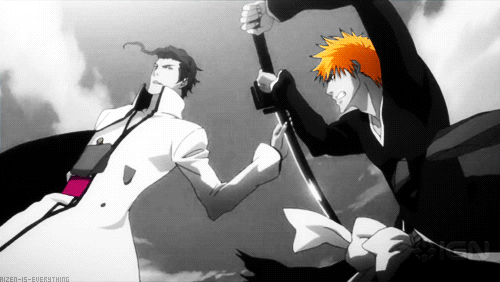
For starters, we have to answer the question as to why Aizen molded and formed Ichigo. Like Aizen said, he knew about Ichigo since before he was born. Aizen was intrigued by the immense power that is gained from hybrid beings, hence why he was so focussed on working and experimenting with the Hōgyoku. Isshin and Masaki were an unexpected but welcome surprise, and in old fashioned Aizen fashion, he adapted and observed. We all know what happened next since Aizen was so kind to narrate it for us, but he spent the next years monitoring Ichigo, and eventually actively forming him. Setting up the battles to push Ichigo to his limits, to slowly but surely become stronger.
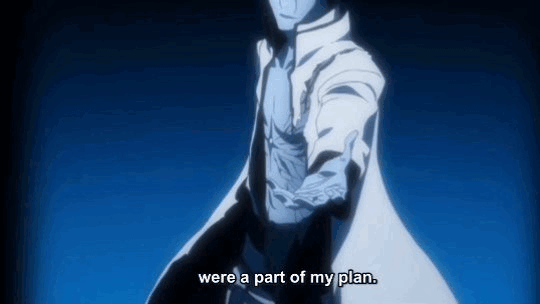
I'm convinced that Aizen would have been disappointed if Ichigo died (which he almost did a couple of times) but at the same time something tells me he had faith that wouldn't happen. Despite putting him in life-threatening situations, he never made an active attempt to kill Ichigo, always leaving some window of opportunity, because he wanted to see how far Ichigo could evolve. Even after defeating Urahara and Isshin, and Ichigo seemed to be at his limits, he still stopped Gin when he made an attempt to finish Ichigo off. He still had hope for Ichigo to grow.
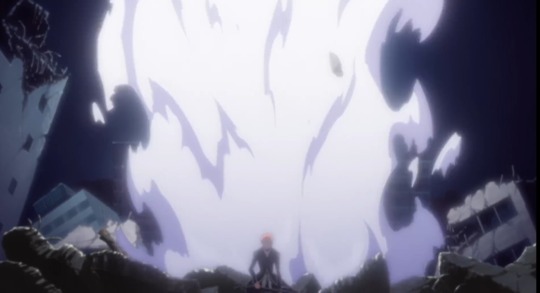
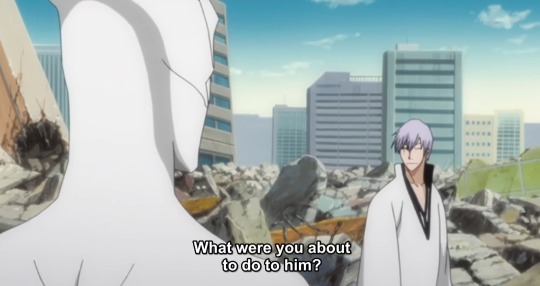
To be clear, he did not do this because he cared about Ichigo's well-being, but because Ichigo is the perfect counterpart. He is the perfect blend of Human, Soul Reaper, Quincy and Hollow. He is the counterweight and closest to an equal powerful force to challenge Aizen's own power. And Aizen wanted to have that, hence why he made sure to keep it around.
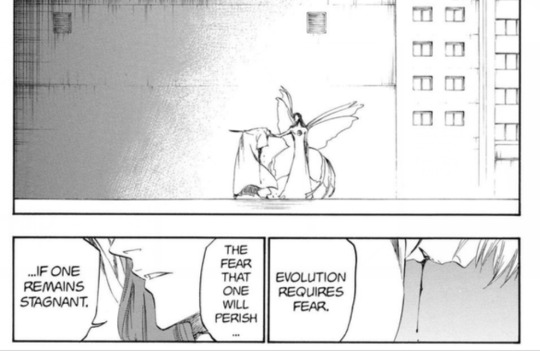
Like he explained to Gin, fear is necessary for evolution. Feeling and experiencing fear is a requirement for him to evolve even further and become stronger himself. Interestingly, this counters Urahara's view on fear, which he explained when training Ichigo in the beginning. According to him, "nothing comes from fear." He actively encourages Ichigo to not acknowledge fear in battles at all.

Whoever is right is up for another debate, (or a matter of personal preference) but what it boils down to for Aizen is that in the end, he firmly believes that anything or anyone powerful should experience fear. And the reason for this is that power in itself should never remain stable. We still don't know Aizen's complete motives, but what is clear is that he refuses to bow down to the everlasting reign of the Soul King. That he firmly believes the position of Soul King, the palace, Squad Zero, all of it, should be challenged. That they should feel fear, and he hates the fact that nobody takes up that role.
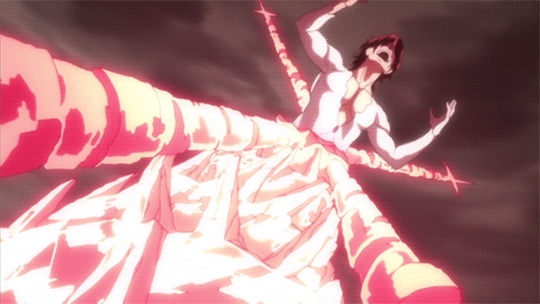
We do get hints that Aizen himself doesn't just want to overthrow that reign, but also wants to take over the place of the Soul King himself. And even though Aizen is an arrogant power hungry bastard, he is not a hypocrite, because he makes sure that his own power is actively challenged as well. Whether that's by empowering Ichigo, keeping Gin close despite suspecting betrayal and never asking anyone to trust him, he makes sure his power is never stagnant.

And because of all that, he also does not use his Shikai against Ichigo. Using his Shikai would mean an immediate advantage, and the challenge that Ichigo provides would be significantly lower. Ergo his power will be unchallenged. It's a strategic move, all crafted according to his own plan. He wants Ichigo at his fullest potential, unhindered. So that he himself will evolve without hindrance as well. To stand at the top himself.
113 notes
·
View notes
Text
In writing my last few posts, I have realized that there is quite a lot of basic(to me) knowledge required to understand most of this stuff. I've done my best to explain as I go, but I think this deserves its own post. So, here we go!
Junior Gemology 101
This post is mostly about diamonds! I am well aware it's called Junior Gemology, but 90% of what I deal with on a day-to-day basis is diamonds. Also, a lot of this applies to coloured stones too, so no need to repeat myself.
What is a diamond, actually?
Diamonds are carbon! That's all there is! Except for inclusions. And coloured diamonds. Those have little bits of other materials in them. And are also a topic for later. I digress. Like always.
Specifically, diamonds are carbon atoms bonded together covalently in a tetrahedral shape. Confusing enough yet? This means that each carbon atom is bonded to 4 other carbon atoms. It's ok if you don't get it, I spent about 3 hours trying to understand diamond structure before things started to make sense. This website has a 3D model of the tetrahedral structure seen in diamonds and is what I used to finally wrap my head around it. The important part is: diamonds are made of carbon atoms connected in a pattern. If the pattern was different, It wouldn't be a diamond! If the carbon was bonded in hexagonal rings, it would be graphite! Same atoms, veeeerrrryyy different result.
What makes diamonds so darn special?
I've told you what a diamond is - so why do people care about this very specific pattern of carbon? The answer is(mostly) that humanity LOVES shiny things, and diamonds are great at being shiny. Why have diamonds become THE shiny thing to have? A combination of some REALLY successful marketing campaigns and some of diamond's unique characteristics. These characteristics include things such as their hardness, brilliance, and fire. I went deeper into these characteristics and what they mean in terms of telling diamonds from other stones in this post, but I'll give you a quick run-down here.
Diamonds are very(and famously) hard. They're a 10 on the Mohs scale, and almost nothing is harder than them. This doesn't mean diamonds are impervious to damage - while they are very hard, diamonds can also be brittle, and a hard smack in the wrong place can chip, crack, or even shatter a diamond. Trust me, I know. I've broken a few by accident.
Brilliance and fire are what give diamonds their characteristic bling. Though they are classified as different things - brilliance being the bright white reflections of light and fire being the rainbow reflections - they're both caused by diamond's Refractive Index. Refractive index(RI) is the measurement of the speed at which light travels through different materials - for our purposes though, think of it as how much a ray of light bends when it moves from one material to another. Diamonds have an RI of 2.42, which causes high brilliance and a medium amount of fire. RI isn't super important for most people to know - it really only comes into the conversation when comparing diamonds to simulant materials.
What are the 4 Cs?
The 4 Cs are the meat and potatoes of diamond basics - Carat weight, Colour, Clarity, and Cut. These four terms are used to describe diamonds worldwide, each describing a different part of a diamond's look.
Carat weight is the weight of a diamond. Pretty self-explanatory. What's not clear is what a carat actually is - no, not a carrot. A carat. A carat is 0.2 grams. Therefore, a 5 carat diamond(good lord) would weigh 1 gram. With me? Why do we weigh diamonds in carats instead of grams like sane people? Because way back yonder, carob seeds were used as a counterweight to weigh diamonds, and language did what language does.

Image from loosegrowndiamond.com
Colour refers to - you guessed it - the colour of the diamond. There are two basic systems that GIA(The Gemological Institute Of America, and the accepted authority of these things in North America) use; the normal colour range and the coloured or fancy diamond range. The normal colour range is used for stones that are colourless, light yellow, or light brown. These are the most common colours of diamond, thus the "normal" colour range. These stones are graded alphabetically D-Z, with D being colourless and Z being quite noticeably yellow or brown. Normal range colour grades are sorted into 5 groups based on the general amount of colour; colourless(DEF), nearly colourless(GHIJ), Faint(KLM), Very Light(N-R), and light(S-Z).

Image from GIA article 4Cs Color
Stones that fall outside this range (stones that are too yellow or brown for the scale or show any colour other than yellow and brown) are graded using the fancy colour grades. Fancy colour grades are an entire thing, but generally pretty self-explanatory. The grade will include 1 or two colours(the more dominant of which goes last) and an intensity descriptor such as light, intense, fancy deep, etc. For example, a stone may be graded as a fancy greyish blue - this means that the stone has a middling amount of colour and is blue with a hint of grey. Easy peasy.
Clarity is how many inclusions are in a stone. Well, technically it's more complicated than that, accounting for placement and contrast and type of inclusion etc etc etc. Really, clarity is how many inclusions you see in a stone. Inclusions are things in the diamond that are not diamond, such as included crystals, or imperfections in the diamond itself, such as cracks(called feathers) or chips.
Clarity grades are, frankly, confusing as fuck. There are 11 grades, broken down into 6 grade groups. From highest to lowest, they are; Flawless, Internally Flawless, Very Very Slightly Included(VVS), Very Slightly Included(VS), Slightly Included(SI), and Included(I). VVS, VS, and SI are each broken into 2 grades - 1 and 2. I is broken down into 3 grades - 1, 2, and 3. The lower the number within a grade, the better the grade - a VS1 stone would be less visibly included than a VS2. You know what'll help? Visuals!!

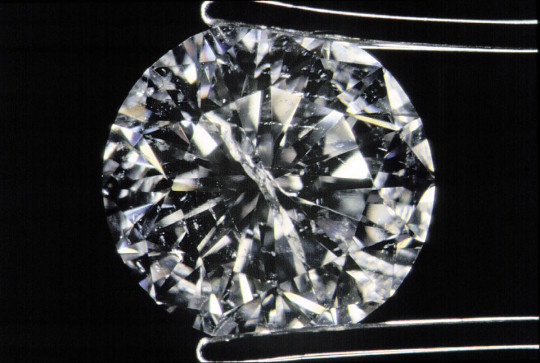
Images from GIA D&DG Chapter 11. Credit to John Koivula/GIA
The diamond on the left is graded as a VVS2 - the red arrow points to the inclusion that gave it this grade. The diamond on the right is graded as an I2. No red arrows are required - this stone has many highly visible inclusions. If you want a little more info (and examples) of clarity grades, GIA has a lovely little tool that explains it quite well.
Cut refers to the shape of a diamond - specifically, the combination of shape(face-up outline) and cutting style(the arrangement of the facets). A classic round brilliant is what most people think of when they think of a diamond, but there are dozens of different cuts. When talking about cut grade, cut refers to how well executed the cut is. Are the proportions ideal? Is everything symmetrical? Is the polish well done? These determine the cut grade of the stone. Cut grades are as follows, best to worst; Excellent, Very Good, Good, Fair, and Poor.
What are the parts of a cut diamond?
Specifically, the parts of a round brilliant diamond. Round brilliant is the name of the most common cut of diamond. Think of a diamond. Is it round? That's almost definitely a round brilliant. Think I've said round brilliant enough? Round brilliant. Whew. Done with that now. This is best explained with diagrams.

The parts we're most interested in are the table, crown, girdle, and pavilion. The way those 3 parts are shaped and proportioned has a huge effect on the looks and value of a diamond.
Knowledge Check
Let's say you're looking at a 1.01 carat round brilliant diamond - it has a colour grade of F, a clarity grade of SI1, and an excellent cut grade. So, what does this mean to you?
Round brilliant is the cut of the diamond. It has a round outline and a brilliant cutting style. 1.01ct is a fairly large diamond - this one in particular is 6.42 mm in diameter (that's a quarter inch!). This stone is colourless - F is the lowest colour grade in the colourless range, but it is still classified as colourless. The diamond will either have one large or several small inclusions that are easy to see under 10x magnification, but hard or impossible to see while looking through the table of a stone with the naked eye(they may be visible through the pavilion with the naked eye). The diamond will be very well cut - the best cut grade possible, in fact! There will be no visible variation in the girdle outline, and all the facets will be well-placed and symmetrical.
It's up to you to decide if this stone matches your criteria - is SI1 a good enough cut grade for you? Is 1.01ct the right size? How "good" a stone is depends on what you want - there will always be bigger, clearer, more colourless diamonds on the market. What makes a stone "good" is if it's the right fit for you. Another stone may be better quality, but if it's out of your price range, then it's not a good stone for you.
In Conclusion
So, you made it this far! Congrats! Hopefully, I haven't bored you too much. We've really just scratched the surface - this was enough information to give you a good idea of what's going on and allow you to navigate the mysticisms of those strange numbers and letters you see associated with diamonds. All information was taken from the GIA Diamond Essentials 130 and Diamonds and Diamond Grading 230 courses and my 6ish years in the jewelry industry. If you have questions about specific pieces of information or want more resources, send me an ask! I will be delighted to answer.
#WOW this on is an absolute beast#final word count is 1674#fun fact this is how i'm studying for my gemology final#long post#goldsmith answers
24 notes
·
View notes
Text

Even before al the bodies have been recovered, the blame game is in full swing over Perini Navi's 55m Bayesian that went down in a storm off Porticello, Sicily. I read this morning the chief of the group that owns Perini Navi came out swinging, putting the blame squarely on the crew.
There's a good technical analysis from designer Chris Feers below the cut.
TL;Don't want to read: Monohulls of all stripes are designed to survive a knockdown; Perini's engineering is some of he best in the world. Bayesian had a retractable keel which could shorten her 32' draft to 12'. With the keel extended, meaning she had full use her counterweight, she would have been able to right herself in a full knockdown. Even if her mast were below the waterline, even if she lost her mast, maybe more so if she lost her mast, assuming she was watertight, her design would allow her to self recover. With the keel retracted tho, her righting moment would be dramatically less. If she wasn't watertight, a knockdown would be unrecoverable and she would, as she did, quickly end up on the bottom of the ocean.
I have so many questions. We won't know the full story for a bit but seven people losing their lives should have been an avoidable outcome.
This is a one in a million tragedy but we should examine the facts and learn from them. Bayesian boasts the second highest mast in the world at 75 metres on a length of 56m. She has a lifting keel to enable her to get into shallow areas. Fully down it gives a draft of 9.83m and raised a draft of 4m. A sailing yacht has a keel to counter the heeling moment generated by the power of her sail plan. I’m sorry to say that size matters to a superyacht owner and naval architects are seduced into providing solutions. As yacht size increases the resistance of the hull reduces in proportion, so less sail area is required to adequately power longer yachts. But these floating fashion items are driven by appearance and bragging rights - and you lose prestige if someone has a bigger mast than you. Always the status pecking order questions are – how big – how fast – what cost – and is it black? If you designed Bayesian with a reasonable sail area and a ‘normal’ mast she would not look impressiive – which is what superyachts have to be.
The stability of a yacht has to be sufficient to counter the power of the rig but, as mast heights increase, the keels can often become so deep that the places of interest are restricted hence the lifting keel solution. Stability comes from two factors – the hull form and the ballast keel which acts like a pendulum. As the yacht heels the volume of the immersed hull section produce a buoyancy force which resists heeling. Initially the keel gives little force but as the angle of heel increases ‘physics’ makes the keel contribution significant (leverage). The greater the keel length, the greater the effect. The combination of the hull buoyancy on the heeled side and the keel on the ‘windward’ side produces the force necessary to keep the yacht from capsize. If the keel of Bayesian was retracted it would lose a significant six meters of moment arm or leverage from its probable 200 tons of keel bulb. When we design yachts we calculate the stability, or righting lever, as a function of heeled ‘bouyancy’ force and the ballast moment arm combined. (the GZ) This can be plotted on a graph to show the stability at any heel angle and identifies the angle at which stability becomes negative causing the yacht to capsize.
Normally an ocean yacht will experience a negative point at about 120 degrees of heel. With a lifting keel this point is greatly reduced maybe to less than 90 degrees. If Bayesian was at anchor with the keel raised and no sail up the crew would have every confidence that she could remain safe in most normal wind conditions. Every captain at this level has passed an exam on stability and would be aware of his vessels stability graph.
Many years ago I sat at Cremorne and watched a spiralling williwaw race across Sydney harbour and pass through Mosman. This twister was only about 30 metres wide but it destroyed houses and overturned cars in its path. A few feet away nothing was harmed.
The power of a twister is intense and powerful with the wind is coming from every direction. This was what hit Bayesian. The problem of large rigs is windage, even with no sails. But this yacht had three furling sails forward and a big boom with the weight of a furled mainsail inside all above the centre of gravity. Also there were a few communication domes on the spreaders.
We use a wind pressure coefficient to measure the force of the wind on the rig and sails. Even without sails the WPC for Bayesian must have been pretty large when hit by a wind force of varying direction with a local velocity way above the norm. Once she was knocked down beyond her stability limit with the keel up she stood no chance and, laying flat to the water, her deck openings would have allowed a flood of water aboard and she would founder. This would happen in a couple of minutes.
The observation of a lightning strike can be discounted because these vessels are grounded and any damage from a strike would have caused a slow sinking at worst – not a capsize and founder.
The individuals within a professional crew with sailing experience may have sensed the wind and motion of the vessel and quickly reacted to instinctively save themselves in the seconds they had. My guess is that some were already on deck alarmed by the general conditions.The guests would have found themselves totally disoriented in flooding cabins, in darkness with the walls, doors and passageways at ninety degrees to the norm. They had practically no chance because it would be completely beyond their experience. The crew would have been unable to be of any help due to the speed of the unexpected event.
I have been a professional yacht designer and builder for fifty years specialising in lifting keel yachts. My son, a professional navigator, was Third Officer on a ketch superyacht with masts 100m tall; a yacht so big, at 88metres, that it was almost beyond human handling even with the machinery on board. But of course it is the biggest and most expensive’ etc etc. What we have here is a one off accident which is a wake up call to an industry where common sense has departed as yachts get more silly in size and design.
In summary Bayesian was caught in the wrong place at the wrong time. A freak accident which the designers and crew would have little chance to predict.
If the keel had been down she would have probably survived the knock down. But without sails up the crew would have experience of her basic stability for normal conditions which would have felt adequate. Any enquiry must examine the design factors such as the stability vanishing point in the condition she was at the time of the accident; keel up, tank loadings and rig factors for windage (WPC) and centre of gravity etc. And a calculation of the wind force required to heel the boat to 90 degrees in the condition at the time of the accident.
All forms of transport have had these unpredictable one off events leading to changes of regulations and professional practice. Titanic, Boeing, 1955 Le Mans, the 1952 Farnborough crash, the 1979 Fastnet – all have made a difference and these events all came unpredicted and out of the blue often at a time of complacency.
Chris Freer – yacht designer – August 2024
8 notes
·
View notes
Text
The diversity, equity, and inclusion (“DEI”) regime has assumed a few names since the summer of 2020, among them: “woke” and “cancel culture.” But it can be more precisely referred to as “critical social justice.”
So, what exactly is critical social justice that so many in the Western world have been forcibly subjected to?
The following is the article ‘‘Counterweight’ to Conformity’ written by Habi Zhang and published by the American Institute for Economic Research (“AEIR”).
Over the past three years, Western societies have devoted immense resources to promoting and even mandating diversity, equity, and inclusion (“DEI”) initiatives and practices, such as anti-racist and unconscious bias training, in almost all spheres of society. Indeed, the DEI regime has become so all-encompassing and penetrating that ordinary people, ones whose life trajectories have no intersection with an academic activist culture or parts of the internet soaked in a cultural war, find their livelihoods are nonetheless entangled, frankly, saddled with, or even jeopardized by a variety of DEI policies, programs and the discourse itself.
So, what exactly is DEI, that over half of workers in the US receive its training at work? What exactly is DEI that companies, universities, and government can require a written commitment to its principles? Isn’t DEI just another name for the commonsensical opposition to discrimination against people on the grounds of their race, sex, sexuality, or any number of immutable attributes? The answer is no.
As Helen Pluckrose writes in her 2024 book ‘The Counterweight Handbook: Principled Strategies for Surviving and Defeating Critical Social Justice—at Work, in Schools, and Beyond’, the DEI regime is “inextricably connected with an illiberal, authoritarian ideology,” which has assumed a few names since the summer of 2020, among them: “woke” and “cancel culture.” But, Pluckrose summarises, it can be more precisely referred to as “critical social justice,” which she understands as a particular “approach to social justice activism.”
7 notes
·
View notes
Text
Chapter 13 Trivia
Extremely rare no-abs shirtless male character from Dr. Stone. Keep this picture safe, it's the only one of its kind…
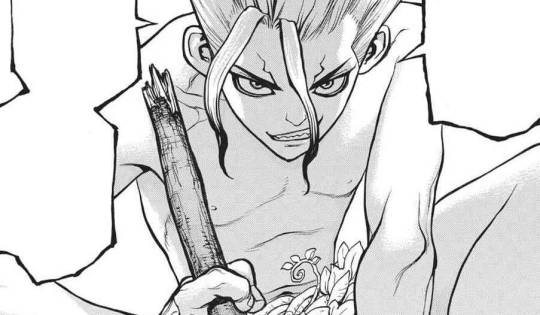
This is the same location as Taiju passed through on his journey, but taken from an angle slightly further back. Some parts look a little different, but the same broken statues are present.
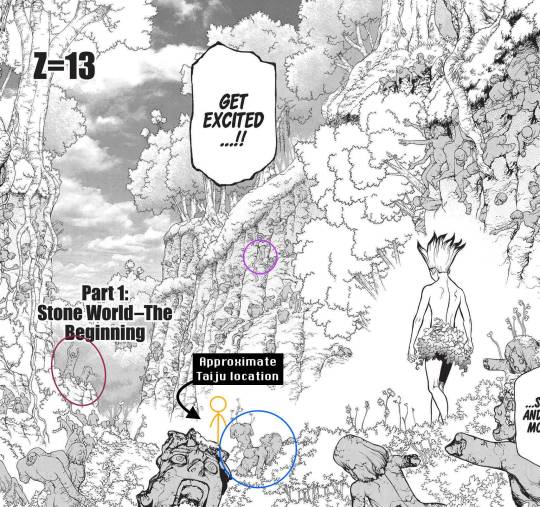
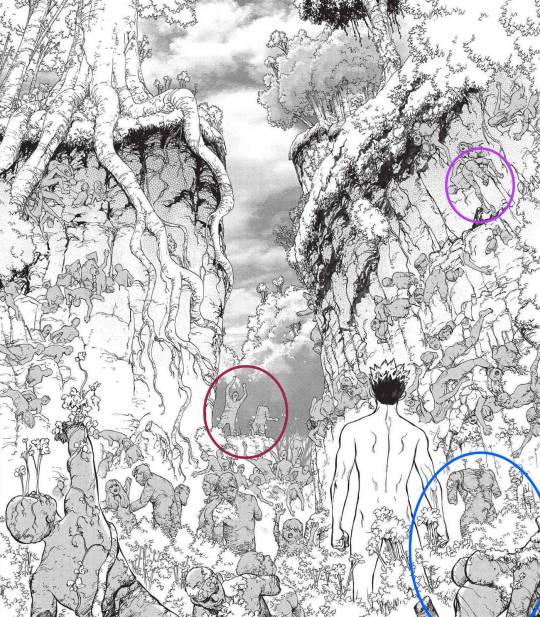
The monkeys that follow Senku around are Japanese macaques, which are a species of Old World monkey present across most of Japan. They are also the most northern-living primate (not counting humans), and as such are adapted to the colder Japanese climate in the year 5738.



Senku couldn't start a fire with this setup, but neither would Taiju or Yuzuriha. The wood is wrong: the bottom should be stable like a plank, with a divot and a notch in it for catching the embers. The drill part should be much thinner, without bark, and rounded at the end.
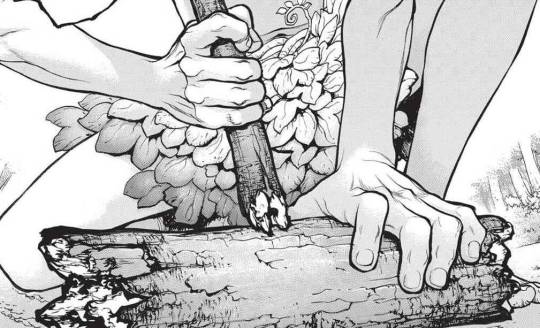
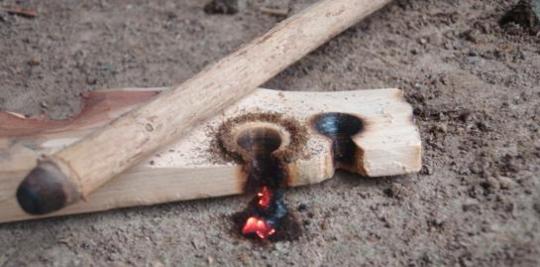
Chert is a 7 on the Mohs scale, so it's hard, but not "off the charts".
Senku uses two percussion techniques to shape the stone: hard-hammer and bipolar. The former is used more frequently as it is more precise, but the latter is used when the stone isn't good quality.
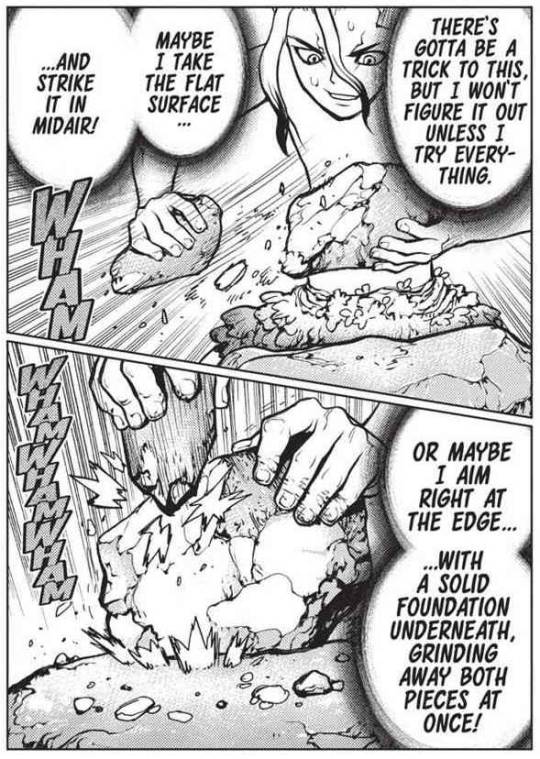
After the rough shaping, Senku grinds the stone to have a polished edge, which makes it more durable. Polishing flint/chert is one of the markers of the transition from the Mesolithic to Neolithic Stone Age, as polished axes were more efficient at clearing trees for farmland.
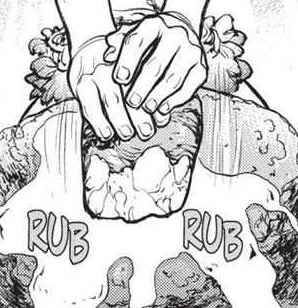
I spent some time testing how to make plant cord, and Senku's methods are correct. Scraping away at the plant removes the bark and non-fiber-y parts leaving the long strings behind. Flax, hemp, and nettles are good plant choices, as they have longer fibers for twisting.
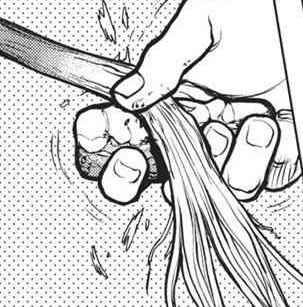
Senku's rope looks like 1-ply, meaning only a single strand is being twisted. This seems to contradict his earlier hand motions, as twisting parts in both hands would result in 2-ply, but his inexperience may be the reason it didn't work correctly. More plys means stronger rope.
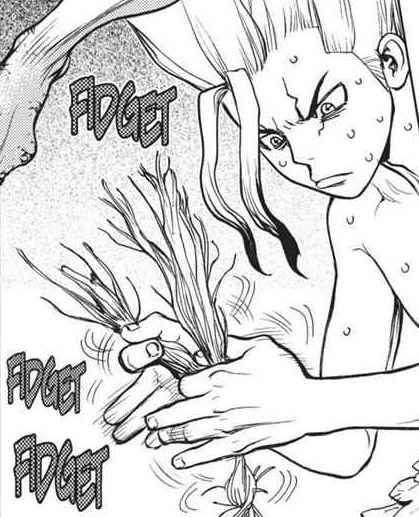
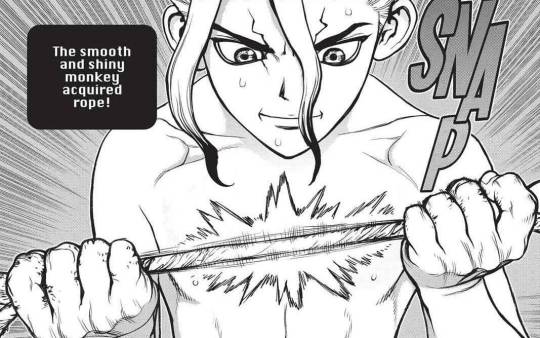

Rubbing sticks raises the heat of the wood through friction, but the goal is to get the wood hot enough to decompose into what's known as pyrolysis products. Those products burn in oxygen, which then raises the heat more and creates a chain reaction, setting the wood on fire.
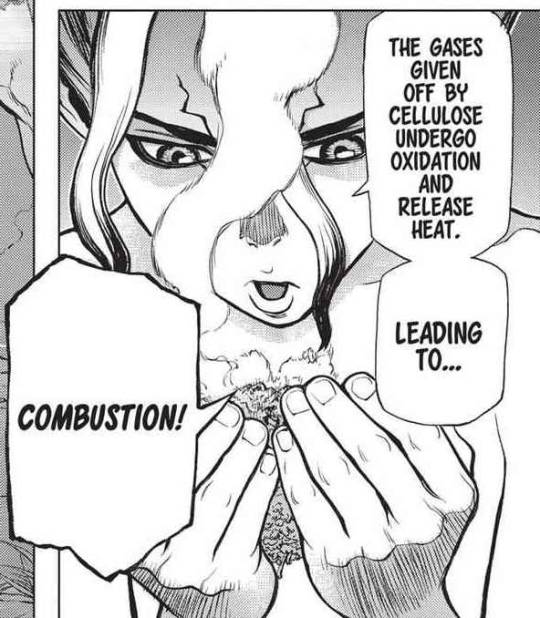
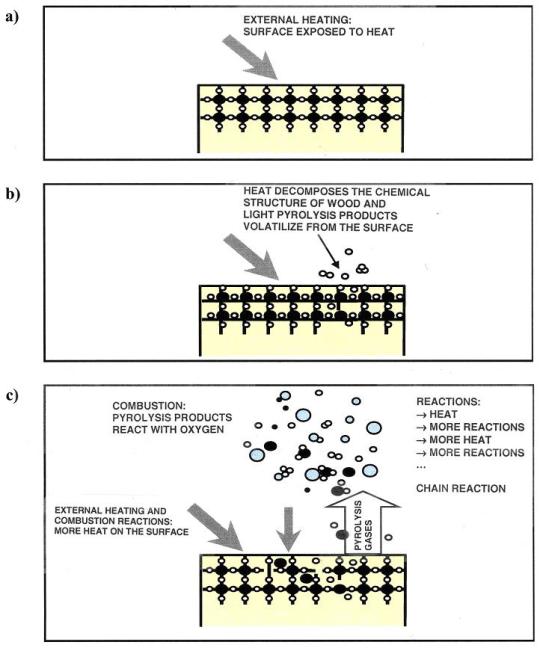
Assuming this deer is an adult Japanese sika deer, it weighs around 40-70kg. Senku at this point probably weighs under 61kg. In order to confidently lift a deer, Senku needs to have a counterweight of at least 70kg.


In this case, he bends a small tree using his own weight (one handed, even), but the chance of this tree being that elastic and capable of lifting over 60kg without simply breaking is almost impossible.
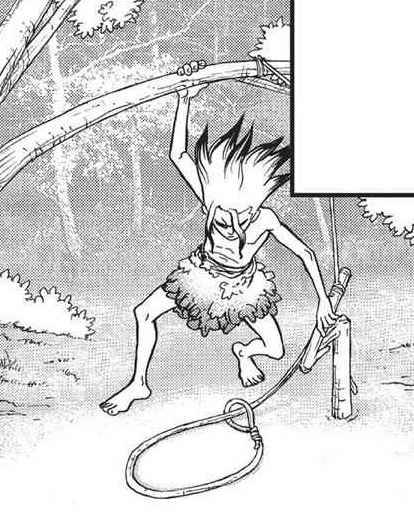
The more realistic option would have been using a counterweight such as a large log or stone, so that when the trap is activated, the counterweight falls and the trapped animal goes up.
However, that requires Senku to be able to lift something that heavy above his head.

Making leather requires several steps that can take several weeks to several months to complete. The hides need to be scraped and soaked in special solutions, have tannins added, and other processes.
The gnawing Senku is doing happens after the tanning, and is used to soften the leather. The modern way to do it is to rub it across a smooth/rounded surface, such as a sawhorse or metal pipe. The bending will make it more supple and won't destroy your jaw.
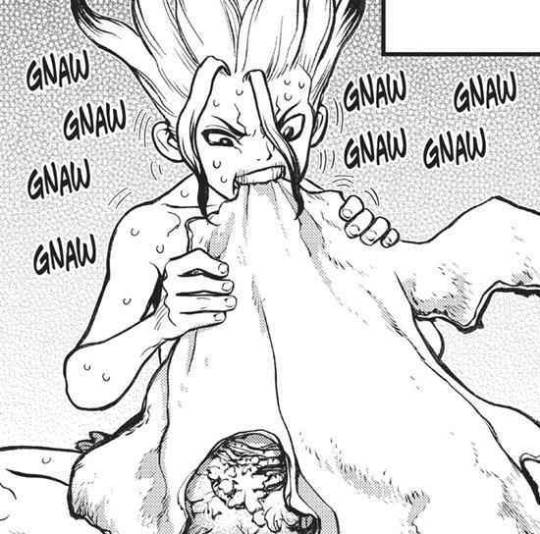
We see that one of the snow monkeys has a baby on their back. Snow monkey babies are normally born from April to June. Four months after birth, the babies are too big to hang from their mother's underside, so they move to her back.
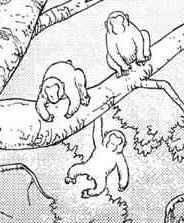
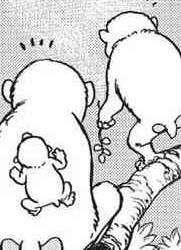
The earliest this time scene could be is therefore August, which is about 2 months before Taiju depetrified. Any of Senku's experiments or builds likely happened in those last 2 months, since we don't see him progress with anything else before then.
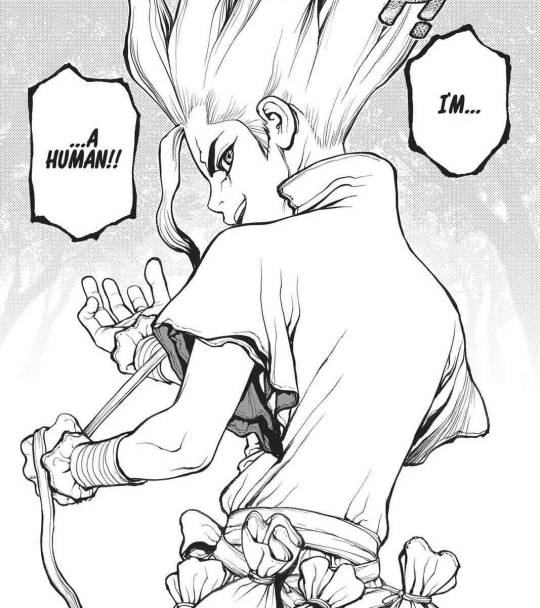
I know this chapter took a while, but the topics were too interesting and also testable so I went a little overboard with how hard I was looking things up haha!
29 notes
·
View notes
Text
Decided not to pollute another post with it, but I do like Discworld's magic. It is a tool, a science, and it is powerful, and dangerous.
It's a common statement in the books that the job of wizards is "not doing magic" - or, after a lot of explanation of what's happened when people turned magic to war, REFRAINING from using it.
But there's a theme that magic has a cost. Early books explained telekinesis required a counterweight to avoid the caster's brain getting pounded flat. It erodes the world, making it less real. Going Postal goes on about how if you tried to feed a country with magic, the cost would be more than you could afford.
Witches look at it differently, but there's a similar conclusion. Use magic to do too many things, and you'll get used to it. Get used to it, and you'll start using it for yourself. And then you start cackling and hear the clanging of the oven door...
(Witches are psychologists and therapists and judges and doctors, and usually have a specialized set of rural skills unique to them. They have tricks and spells and real magic, but rarely see a point in using anything more than their heads to do things.)
141 notes
·
View notes
Text
https://web.archive.org/web/20150722184851/https://www.wsj.com/articles/SB123275572295011847
How Israel Helped to Spawn Hamas
By Andrew Higgins
Updated Jan. 24, 2009 12:01 a.m. ET
Moshav Tekuma, Israel
Surveying the wreckage of a neighbor's bungalow hit by a Palestinian rocket, retired Israeli official Avner Cohen traces the missile's trajectory back to an "enormous, stupid mistake" made 30 years ago.
"Hamas, to my great regret, is Israel's creation," says Mr. Cohen, a Tunisian-born Jew who worked in Gaza for more than two decades. Responsible for religious affairs in the region until 1994, Mr. Cohen watched the Islamist movement take shape, muscle aside secular Palestinian rivals and then morph into what is today Hamas, a militant group that is sworn to Israel's destruction.
Instead of trying to curb Gaza's Islamists from the outset, says Mr. Cohen, Israel for years tolerated and, in some cases, encouraged them as a counterweight to the secular nationalists of the Palestine Liberation Organization and its dominant faction, Yasser Arafat's Fatah. Israel cooperated with a crippled, half-blind cleric named Sheikh Ahmed Yassin, even as he was laying the foundations for what would become Hamas. Sheikh Yassin continues to inspire militants today; during the recent war in Gaza, Hamas fighters confronted Israeli troops with "Yassins," primitive rocket-propelled grenades named in honor of the cleric.
Last Saturday, after 22 days of war, Israel announced a halt to the offensive. The assault was aimed at stopping Hamas rockets from falling on Israel. Prime Minister Ehud Olmert hailed a "determined and successful military operation." More than 1,200 Palestinians had died. Thirteen Israelis were also killed.
Hamas responded the next day by lobbing five rockets towards the Israeli town of Sderot, a few miles down the road from Moshav Tekuma, the farming village where Mr. Cohen lives. Hamas then announced its own cease-fire.
Since then, Hamas leaders have emerged from hiding and reasserted their control over Gaza. Egyptian-mediated talks aimed at a more durable truce are expected to start this weekend. President Barack Obama said this week that lasting calm "requires more than a long cease-fire" and depends on Israel and a future Palestinian state "living side by side in peace and security."
A look at Israel's decades-long dealings with Palestinian radicals -- including some little-known attempts to cooperate with the Islamists -- reveals a catalog of unintended and often perilous consequences. Time and again, Israel's efforts to find a pliant Palestinian partner that is both credible with Palestinians and willing to eschew violence, have backfired. Would-be partners have turned into foes or lost the support of their people.
Israel's experience echoes that of the U.S., which, during the Cold War, looked to Islamists as a useful ally against communism. Anti-Soviet forces backed by America after Moscow's 1979 invasion of Afghanistan later mutated into al Qaeda.
At stake is the future of what used to be the British Mandate of Palestine, the biblical lands now comprising Israel and the Palestinian territories of the West Bank and Gaza. Since 1948, when the state of Israel was established, Israelis and Palestinians have each asserted claims over the same territory.
The Palestinian cause was for decades led by the PLO, which Israel regarded as a terrorist outfit and sought to crush until the 1990s, when the PLO dropped its vow to destroy the Jewish state. The PLO's Palestinian rival, Hamas, led by Islamist militants, refused to recognize Israel and vowed to continue "resistance." Hamas now controls Gaza, a crowded, impoverished sliver of land on the Mediterranean from which Israel pulled out troops and settlers in 2005.
When Israel first encountered Islamists in Gaza in the 1970s and '80s, they seemed focused on studying the Quran, not on confrontation with Israel. The Israeli government officially recognized a precursor to Hamas called Mujama Al-Islamiya, registering the group as a charity. It allowed Mujama members to set up an Islamic university and build mosques, clubs and schools. Crucially, Israel often stood aside when the Islamists and their secular left-wing Palestinian rivals battled, sometimes violently, for influence in both Gaza and the West Bank.
"When I look back at the chain of events I think we made a mistake," says David Hacham, who worked in Gaza in the late 1980s and early '90s as an Arab-affairs expert in the Israeli military. "But at the time nobody thought about the possible results."
Israeli officials who served in Gaza disagree on how much their own actions may have contributed to the rise of Hamas. They blame the group's recent ascent on outsiders, primarily Iran. This view is shared by the Israeli government. "Hamas in Gaza was built by Iran as a foundation for power, and is backed through funding, through training and through the provision of advanced weapons," Mr. Olmert said last Saturday. Hamas has denied receiving military assistance from Iran.
Arieh Spitzen, the former head of the Israeli military's Department of Palestinian Affairs, says that even if Israel had tried to stop the Islamists sooner, he doubts it could have done much to curb political Islam, a movement that was spreading across the Muslim world. He says attempts to stop it are akin to trying to change the internal rhythms of nature: "It is like saying: 'I will kill all the mosquitoes.' But then you get even worse insects that will kill you...You break the balance. You kill Hamas you might get al Qaeda."
When it became clear in the early 1990s that Gaza's Islamists had mutated from a religious group into a fighting force aimed at Israel -- particularly after they turned to suicide bombings in 1994 -- Israel cracked down with ferocious force. But each military assault only increased Hamas's appeal to ordinary Palestinians. The group ultimately trounced secular rivals, notably Fatah, in a 2006 election supported by Israel's main ally, the U.S.
Now, one big fear in Israel and elsewhere is that while Hamas has been hammered hard, the war might have boosted the group's popular appeal. Ismail Haniyeh, head of the Hamas administration in Gaza, came out of hiding last Sunday to declare that "God has granted us a great victory."
Most damaged from the war, say many Palestinians, is Fatah, now Israel's principal negotiating partner. "Everyone is praising the resistance and thinks that Fatah is not part of it," says Baker Abu-Baker, a longtime Fatah supporter and author of a book on Hamas.
A Lack of Devotion
Hamas traces its roots back to the Muslim Brotherhood, a group set up in Egypt in 1928. The Brotherhood believed that the woes of the Arab world spring from a lack of Islamic devotion. Its slogan: "Islam is the solution. The Quran is our constitution." Its philosophy today underpins modern, and often militantly intolerant, political Islam from Algeria to Indonesia.
After the 1948 establishment of Israel, the Brotherhood recruited a few followers in Palestinian refugee camps in Gaza and elsewhere, but secular activists came to dominate the Palestinian nationalist movement.
At the time, Gaza was ruled by Egypt. The country's then-president, Gamal Abdel Nasser, was a secular nationalist who brutally repressed the Brotherhood. In 1967, Nasser suffered a crushing defeat when Israel triumphed in the six-day war. Israel took control of Gaza and also the West Bank.
"We were all stunned," says Palestinian writer and Hamas supporter Azzam Tamimi. He was at school at the time in Kuwait and says he became close to a classmate named Khaled Mashaal, now Hamas's Damascus-based political chief. "The Arab defeat provided the Brotherhood with a big opportunity," says Mr. Tamimi.
In Gaza, Israel hunted down members of Fatah and other secular PLO factions, but it dropped harsh restrictions imposed on Islamic activists by the territory's previous Egyptian rulers. Fatah, set up in 1964, was the backbone of the PLO, which was responsible for hijackings, bombings and other violence against Israel. Arab states in 1974 declared the PLO the "sole legitimate representative" of the Palestinian people world-wide.
The Muslim Brotherhood, led in Gaza by Sheikh Yassin, was free to spread its message openly. In addition to launching various charity projects, Sheikh Yassin collected money to reprint the writings of Sayyid Qutb, an Egyptian member of the Brotherhood who, before his execution by President Nasser, advocated global jihad. He is now seen as one of the founding ideologues of militant political Islam.
Mr. Cohen, who worked at the time for the Israeli government's religious affairs department in Gaza, says he began to hear disturbing reports in the mid-1970s about Sheikh Yassin from traditional Islamic clerics. He says they warned that the sheikh had no formal Islamic training and was ultimately more interested in politics than faith. "They said, 'Keep away from Yassin. He is a big danger,'" recalls Mr. Cohen.
Instead, Israel's military-led administration in Gaza looked favorably on the paraplegic cleric, who set up a wide network of schools, clinics, a library and kindergartens. Sheikh Yassin formed the Islamist group Mujama al-Islamiya, which was officially recognized by Israel as a charity and then, in 1979, as an association. Israel also endorsed the establishment of the Islamic University of Gaza, which it now regards as a hotbed of militancy. The university was one of the first targets hit by Israeli warplanes in the recent war.
Brig. General Yosef Kastel, Gaza's Israeli governor at the time, is too ill to comment, says his wife. But Brig. Gen. Yitzhak Segev, who took over as governor in Gaza in late 1979, says he had no illusions about Sheikh Yassin's long-term intentions or the perils of political Islam. As Israel's former military attache in Iran, he'd watched Islamic fervor topple the Shah. However, in Gaza, says Mr. Segev, "our main enemy was Fatah," and the cleric "was still 100% peaceful" towards Israel. Former officials say Israel was also at the time wary of being viewed as an enemy of Islam.
Mr. Segev says he had regular contact with Sheikh Yassin, in part to keep an eye on him. He visited his mosque and met the cleric around a dozen times. It was illegal at the time for Israelis to meet anyone from the PLO. Mr. Segev later arranged for the cleric to be taken to Israel for hospital treatment. "We had no problems with him," he says.
In fact, the cleric and Israel had a shared enemy: secular Palestinian activists. After a failed attempt in Gaza to oust secularists from leadership of the Palestinian Red Crescent, the Muslim version of the Red Cross, Mujama staged a violent demonstration, storming the Red Crescent building. Islamists also attacked shops selling liquor and cinemas. The Israeli military mostly stood on the sidelines.
Mr. Segev says the army didn't want to get involved in Palestinian quarrels but did send soldiers to prevent Islamists from burning down the house of the Red Crescent's secular chief, a socialist who supported the PLO.
'An Alternative to the PLO'
Clashes between Islamists and secular nationalists spread to the West Bank and escalated during the early 1980s, convulsing college campuses, particularly Birzeit University, a center of political activism.
As the fighting between rival student factions at Birzeit grew more violent, Brig. Gen. Shalom Harari, then a military intelligence officer in Gaza, says he received a call from Israeli soldiers manning a checkpoint on the road out of Gaza. They had stopped a bus carrying Islamic activists who wanted to join the battle against Fatah at Birzeit. "I said: 'If they want to burn each other let them go,'" recalls Mr. Harari.
A leader of Birzeit's Islamist faction at the time was Mahmoud Musleh, now a pro-Hamas member of a Palestinian legislature elected in 2006. He recalls how usually aggressive Israeli security forces stood back and let conflagration develop. He denies any collusion between his own camp and the Israelis, but says "they hoped we would become an alternative to the PLO."
A year later, in 1984, the Israeli military received a tip-off from Fatah supporters that Sheikh Yassin's Gaza Islamists were collecting arms, according to Israeli officials in Gaza at the time. Israeli troops raided a mosque and found a cache of weapons. Sheikh Yassin was jailed. He told Israeli interrogators the weapons were for use against rival Palestinians, not Israel, according to Mr. Hacham, the military affairs expert who says he spoke frequently with jailed Islamists. The cleric was released after a year and continued to expand Mujama's reach across Gaza.
Around the time of Sheikh Yassin's arrest, Mr. Cohen, the religious affairs official, sent a report to senior Israeli military and civilian officials in Gaza. Describing the cleric as a "diabolical" figure, he warned that Israel's policy towards the Islamists was allowing Mujama to develop into a dangerous force.
"I believe that by continuing to turn away our eyes, our lenient approach to Mujama will in the future harm us. I therefore suggest focusing our efforts on finding ways to break up this monster before this reality jumps in our face," Mr. Cohen wrote.
Mr. Harari, the military intelligence officer, says this and other warnings were ignored. But, he says, the reason for this was neglect, not a desire to fortify the Islamists: "Israel never financed Hamas. Israel never armed Hamas."
Roni Shaked, a former officer of Shin Bet, Israel's internal security service, and author of a book on Hamas, says Sheikh Yassin and his followers had a long-term perspective whose dangers were not understood at the time. "They worked slowly, slowly, step by step according to the Muslim Brotherhood plan."
Declaring Jihad
In 1987, several Palestinians were killed in a traffic accident involving an Israeli driver, triggering a wave of protests that became known as the first Intifada, Mr. Yassin and six other Mujama Islamists launched Hamas, or the Islamic Resistance Movement. Hamas's charter, released a year later, is studded with anti-Semitism and declares "jihad its path and death for the cause of Allah its most sublime belief."
Israeli officials, still focused on Fatah and initially unaware of the Hamas charter, continued to maintain contacts with the Gaza Islamists. Mr. Hacham, the military Arab affairs expert, remembers taking one of Hamas's founders, Mahmoud Zahar, to meet Israel's then defense minister, Yitzhak Rabin, as part of regular consultations between Israeli officials and Palestinians not linked to the PLO. Mr. Zahar, the only Hamas founder known to be alive today, is now the group's senior political leader in Gaza.
In 1989, Hamas carried out its first attack on Israel, abducting and killing two soldiers. Israel arrested Sheikh Yassin and sentenced him to life. It later rounded up more than 400 suspected Hamas activists, including Mr. Zahar, and deported them to southern Lebanon. There, they hooked up with Hezbollah, the Iran-backed A-Team of anti-Israeli militancy.
Many of the deportees later returned to Gaza. Hamas built up its arsenal and escalated its attacks, while all along maintaining the social network that underpinned its support in Gaza.
Meanwhile, its enemy, the PLO, dropped its commitment to Israel's destruction and started negotiating a two-state settlement. Hamas accused it of treachery. This accusation found increasing resonance as Israel kept developing settlements on occupied Palestinian land, particularly the West Bank. Though the West Bank had passed to the nominal control of a new Palestinian Authority, it was still dotted with Israeli military checkpoints and a growing number of Israeli settlers.
Unable to uproot a now entrenched Islamist network that had suddenly replaced the PLO as its main foe, Israel tried to decapitate it. It started targeting Hamas leaders. This, too, made no dent in Hamas's support, and sometimes even helped the group. In 1997, for example, Israel's Mossad spy agency tried to poison Hamas's exiled political leader Mr. Mashaal, who was then living in Jordan.
The agents got caught and, to get them out of a Jordanian jail, Israel agreed to release Sheikh Yassin. The cleric set off on a tour of the Islamic world to raise support and money. He returned to Gaza to a hero's welcome.
Efraim Halevy, a veteran Mossad officer who negotiated the deal that released Sheikh Yassin, says the cleric's freedom was hard to swallow, but Israel had no choice. After the fiasco in Jordan, Mr. Halevy was named director of Mossad, a position he held until 2002. Two years later, Sheikh Yassin was killed by an Israeli air strike.
Mr. Halevy has in recent years urged Israel to negotiate with Hamas. He says that "Hamas can be crushed," but he believes that "the price of crushing Hamas is a price that Israel would prefer not to pay." When Israel's authoritarian secular neighbor, Syria, launched a campaign to wipe out Muslim Brotherhood militants in the early 1980s it killed more than 20,000 people, many of them civilians.
In its recent war in Gaza, Israel didn't set the destruction of Hamas as its goal. It limited its stated objectives to halting the Islamists' rocket fire and battering their overall military capacity. At the start of the Israeli operation in December, Defense Minister Ehud Barak told parliament that the goal was "to deal Hamas a severe blow, a blow that will cause it to stop its hostile actions from Gaza at Israeli citizens and soldiers."
Walking back to his house from the rubble of his neighbor's home, Mr. Cohen, the former religious affairs official in Gaza, curses Hamas and also what he sees as missteps that allowed Islamists to put down deep roots in Gaza.
He recalls a 1970s meeting with a traditional Islamic cleric who wanted Israel to stop cooperating with the Muslim Brotherhood followers of Sheikh Yassin: "He told me: 'You are going to have big regrets in 20 or 30 years.' He was right."
17 notes
·
View notes